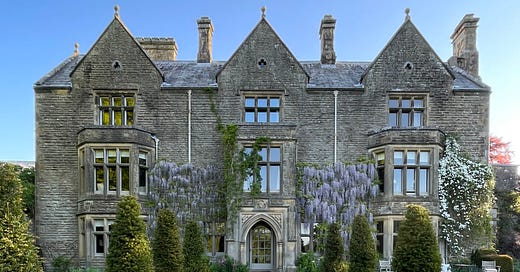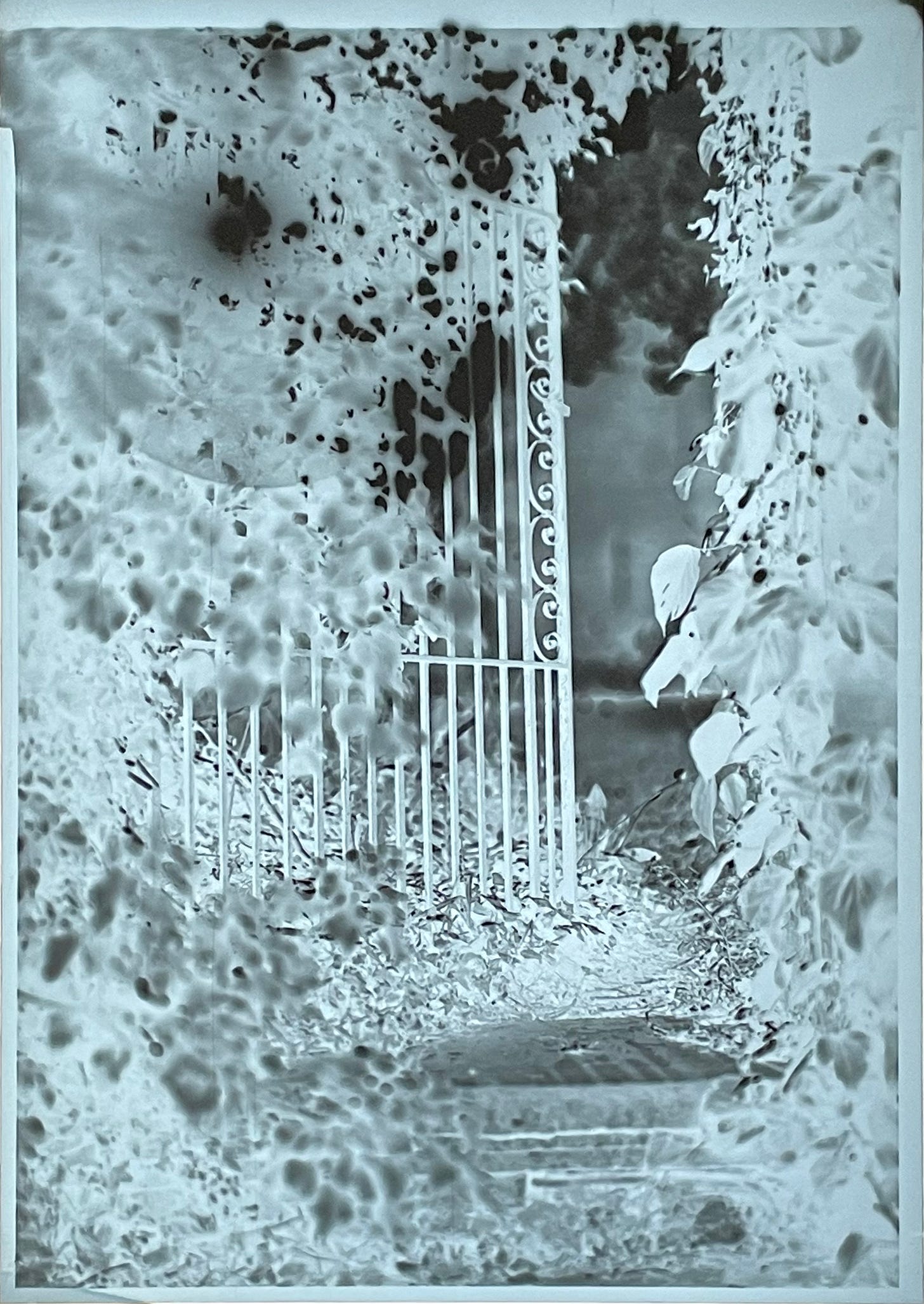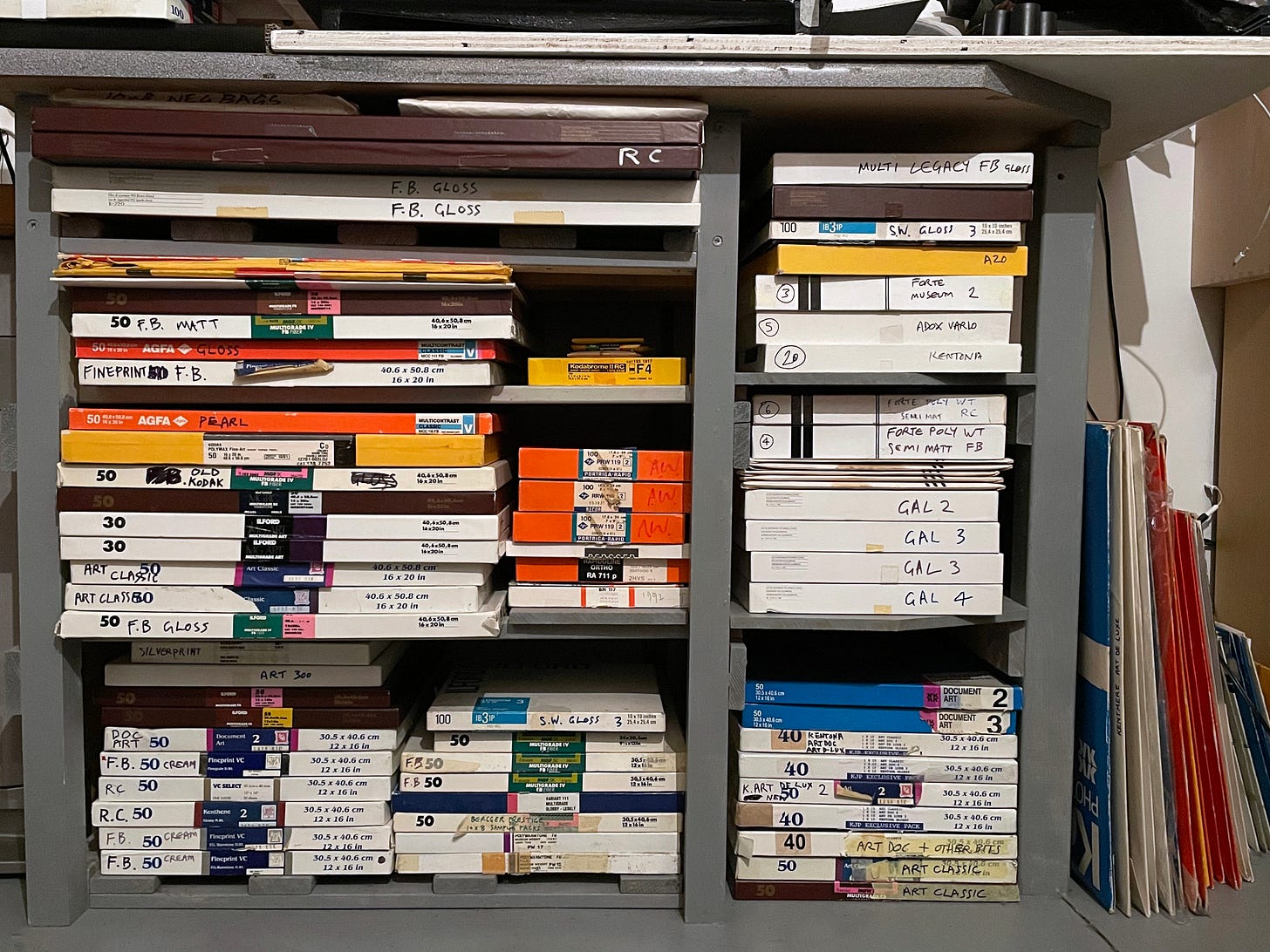About two weeks ago I found myself at an amazing old house in North Yorkshire. My wife was running a painting workshop there and I spent the whole day exploring and taking pictures. I shot 35mm, 6x7, 5x4 and 5x7. I was using FP4, HP5, X-Ray film and paper in the cameras.
The house dates from the early 1600’s and has been in the same family since it was built. The owners, Mark and Charlotte were really lovely people and they gave me complete freedom to photograph all over. The house is pretty big by anybody’s standards and there were many rooms that I didn’t even look in. But because it was a beautiful spring day, I spent most of my time out in the garden exploring. I was so inspired by the place that I was buzzing like I’d had five coffees! Mark was really interested in the large format cameras and did some phone video of me shooting there. There is enough for an Instagram reel, but I haven’t edited it down yet.
It took me a week to get throught my processing and one of the first 5x7 negatives was a shot of an old gate with the house in the background.
I put it in the enlarger and set up to make a print on 10x8 Legacy Multicontrast paper. I had to faff around with split grade printing to get the print to work because X-ray film has a blue base. This confuses the blue/green sensitive emulsion of Multigrade papers and causes increased contrast. I needed to veer more towards grade 00 than a normal neg would have required to compensate for this base colour.
The final print was not what I had in mind, it looked muddy in the shadow areas, so I looked around the darkroom for another paper to work with. I have quite a range of papers in all sorts of sizes, mainly from when friends went digital and donated what paper they had left. Much of it is age fogged and only good for lith printing.
For those of you not familiar with darkroom printing, photographic papers work really well when they are fresh (like most things), The older the paper, the more likely it is to be grey where it should be white. Some papers can last a decade or more, but some are noticeably different after only five years. Many old printers suggest adding 5 ml of 1% Benzotriazole per litre of developer working solution to reduce age fog. Personally I have never used it so I can’t comment. Lith printing uses different developing agents and doesn’t seem to cause the chemical reaction responsible for the fogging, though the look of a lith print isn’t always desirable.
For the negative I was printing, I had in mind a fixed grade paper to avoid the problem with the blue base negative and a paper with rich shadow detail, something like the really old Agfa papers, all of which are no longer available. For those who don’t know, Agfa was one of the legendary names in German photography, founded in 1867 and they produced wonderful films, papers and developers. Rodinal still survives, though it is made by Adox now I believe. here is a short article about Agfa’s history; https://analoguewonderland.co.uk/pages/agfaphoto
I have some boxes and packets of Agfa Multi Contrast Classic FB which was a lovely paper, but most are very grey when processed as these are about twenty years old. Because they were so rare I had been saving them for special images, but when I tested them a few years ago I found that most were too far gone to be of any use. I don’t print lith much these days, so they stay on the darkroom shelves and are largely forgotten.
Agfa Multi Contrast Classic 10x8 boxes. Notice the numbers on the left side of the boxes. Now look at my tests of these papers, all done at the same time.
I have this grid stuck to my darkroom wall as a quick reference. There is a huge difference between number 11 and number 15.
Two of my most favourite papers were discontinued long, long ago, I think it was around the 2000’s; Agfa Portriga and Record Rapid. The oldest versions of this paper were the best, as they were required to remove the cadmium* from it in 1988 and this changed its characteristics. I still have some small (roughly 7x9.5 inches) boxes of these older papers, which I bought as out of date paper in 1986! Again, I was saving these for images that needed the rich shadow detail that these papers provide. I also loved the way these papers behaved in sepia and selenium toners. It had been a long time since I tested a small piece from one of these boxes, but I remembered that it was rather grey, which had been a huge disappointment at the time.
I decided to test it again with the gate negative I mentioned above. I was thinking that I could lighten the fogged highlights a bit with a Potassium Ferricyanide/potassium Bromide bleach and this might look rather interesting.
The first test showed fogging fairly early in the development and I could see it getting worse as I approached the end of the second minute in developer. It occured to me that I should save this test and stick it to the front of the box so I could see at a glance how it printed the next time I pulled this box out. I had two other boxes out at the same time, so I thought that I might as well do the same with those while I was at it. I could then see which boxes were affected the most and which were sort of ok.
I discovered that the second box had never been opened and when I developed it I was surprised and delighted to see that it had no age fogging! 100 sheets of almost perfect Agfa Record Rapid, what a find!
Top image, good box. Bottom image, typical fogging.
I found this at the end of a long printing session, so I was looking forward to getting back in there with fresh chemicals to really get the best out of it. I had remembered that these old Agfa papers were susceptible to staining from developer remaining in the fibres and reacting with the fix, so it is important to make sure you use a fresh stop bath for at least one minute before fixing.
Second printing session.
I got to the darkroom at about 11.00 am and mixed up fresh chemicals. I had remembered my exposure from yesterday (16 seconds) and went for a full print. Stupid mistake. Never assume that the enlarger is going to be the same brightness the following day, especially if it is a cold-cathode light source. The print was too dark, it looked as if it had been given about 25% extra exposure. The extra darkness was probably also due to the more active developer, compared to the used bath the day before.
Back to a test strip and the next print was just about right, so I decided to do a comparison print from the fogged box. Weirdly it didn’t look too bad, certainly nowhere near as grey as the test I did yesterday. This is probably because yesterdays test was done at the end of a session when the developer was not at its best. This is how darkroom work goes though, the gremlins make sure that you can never be absolutely certain of anything. Sometimes they are just having a laugh, but other times they make every test strip and print a disaster. It wasn’t quite that bad today, but I had to be on my toes.
I often make more than one test strip of a negative before I go ahead with a full print because I hate wasting full sheets on a print that isn’t right. A basic test should tell you what is happening in the highlights and the shadows, if your contrast is about right then you should be able to see tone and detail in both, on one section of the test. A second test is usually made to fine tune the contrast and a third is made to determine how much exposure is needed for any burning in that is necessary.
In my haste I had made just this one test and gone for a full print. Immediately I could see that the image needed darkening down a bit in three places. Try again.
This exposure worked out at 10 seconds with five seconds burning in, in three places. The final print was just what I was looking for and I put it through Developer, stop and fix. After a good wash I decided to give it some time in a selenium bath. One of the things I loved about this paper was how it would split tone better than any other paper. The deepest, darkest tones could sometimes take on quite a strong rusty plum colour in selenium and this was what I was after.
All in all I made four versions of this image and experimented with bleaching back the highlights on a couple of them. I sepia toned one print, and it came out rather ginger coloured. Three were toned in Selenium to different degrees.
All four of these prints are for sale in my online shop at £95.00 each; andrewsandersonphotography.bigcartel.com/product/old-metal-gate-langcliffe-hall
*Cadmium in other than tiny quantities too small for industrial usage has been banned in the US ever since the mid-60's. The EU gives a small exemption for small batch artist pigment manufacture only, but is otherwise on a total ban mode. ……. And it really is hazardous. I've known seriously messed up painters who smeared cadmium pigments with their fingers. And in this area there were once industrial paint factories where now it's illegal to even drill a hole in asphalt of concrete without a special permit because there's so much cadmium, lead, and chromium capped off in the soil underneath. I've had several friends die prematurely due to working in those kinds of places, or in shipyards where such coatings were applied.
And no - it's not safe even if you get a little on your paws, like that artist pigment link states. A little here, a little there.... it all adds up, just like lead poisoning. And just like darkroom work, there is a logical reason disposable nitrile gloves were invented. Drew Wiley.
If you find my articles interesting or useful, please spread the word to anyone you can think of who would be interested.
If you have enjoyed this post and the information here and elsewhere on my Substack and you would like to support me, you can subscribe or just buy me a coffee at Ko-fi.com/andrewsandersonphotography You can send as little as £3.00, or more if you are feeling generous. This money goes towards materials used for the tests and printing for these articles. Alternatively you can be a paid subscriber.
Thank you for reading, please let me know your thoughts.
Andrew Sanderson May 2025.










Wow what a place. Great article Sandy, very informative as usual.
Thanks for this article. I have got a few boxes of Agfa portriga and record rapid too. My next darkroom session will be an Agfa Session.
Usually I use old papers only for lithprinting or sunprints or chemigrams ...
After reading your article I want to make prints and I'll test my papers with normal developer. Perhaps I'll be frustrated but darkroom work is full of surprise...